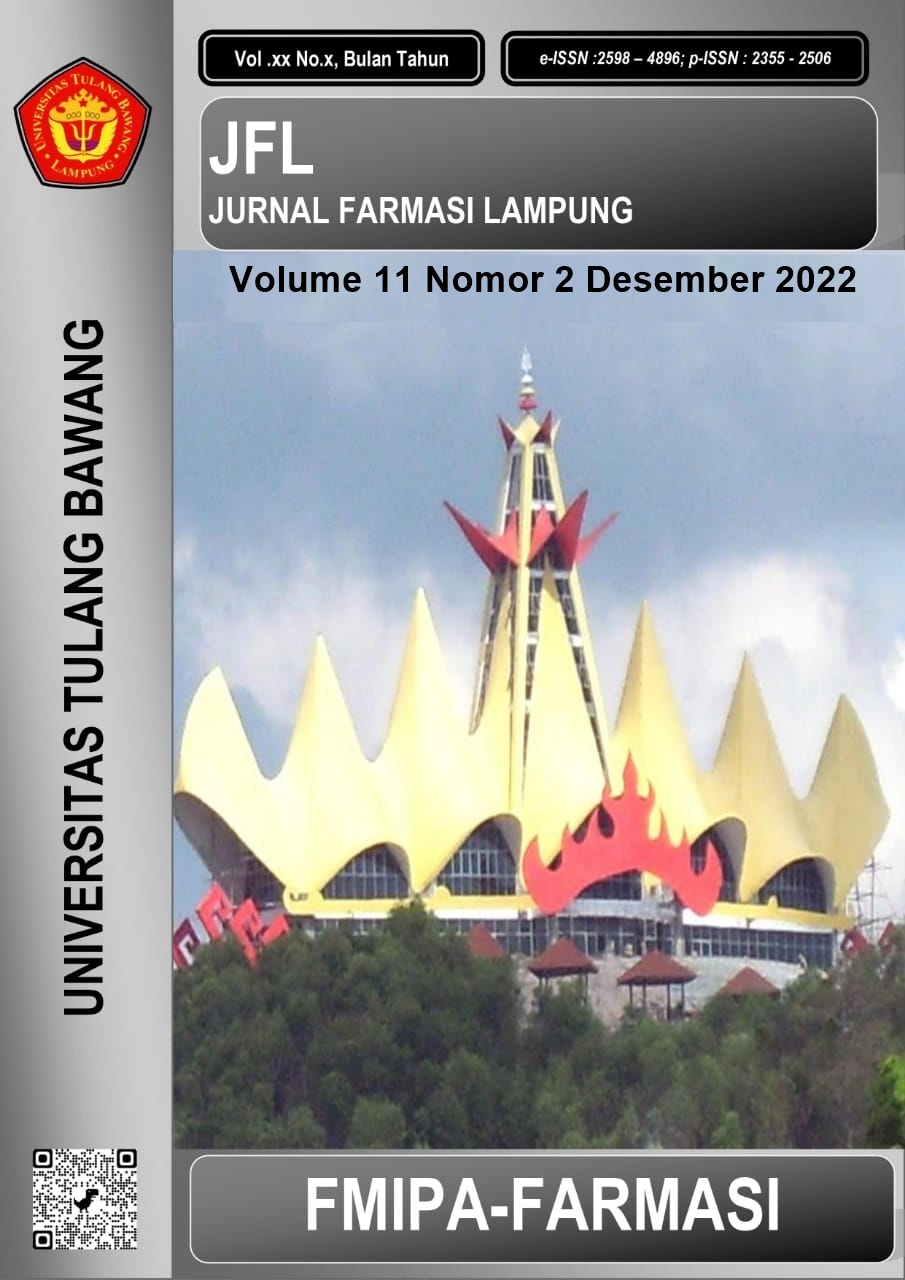KOMBINASI EKSTRAK DAUN BIDARADENGAN DAUN KEMANGI SEBAGAI ANTIBAKTERI TERHADAP Staphylococcus aureus DAN Escherichia coli.
DOI:
https://doi.org/10.37090/jfl.v11i2.807Abstract
Infectious diseases are still at the top of the list of causes of illness and death in developing countries including Indonesia, Staphylococcus aureus and Escherichia coli are commonly found around the human environment, therefore prevention is needed to reduce infection by utilizing plants that have antibacterial effects such as bidara leaves with basil leaves. This study aims to determine the antibacterial activity of the combination of bidara leaf extract and basil leaves, and to determine the best combination concentration in inhibiting the growth of Staphylococcus aureus and Escherichia coli bacteria compared to single extracts and positive controls. Using the diffusion method, the combination of dau bidara extract with basil leaves is K1 (0% + 100 %), K2 (20 + 80%), K3 (40% + 60%), K4 (50% + 50%), K5 (60 %+40%), K6 (80% + 20%), K7 (100% + 0%), K(-) Aquadest and K(+) Ampicillin. In the bacterial test (well diffusion method). The variable measured in this study was the diameter of the inhibition zone formed by the combination of extracts. Data analysis was tested using One Way Anova. The sig value for Staphylococcus aureus was 0.000≤0.05, while for Escherichia coli was 0.000≤0.05, it indicated that there was a significant difference between the test groups. The results of this study obtained the largest inhibition zone on bacteria, S. aureus, namely at K7 14.46 mm had a strong inhibitory response, while in bacteria E. Coli was found in K7 with the largest average value of 17.95 mm having a strong inhibitory response. This study can be concluded that the combination of bidara leaves and basil leaves has greater antibacterial power against Staphylococcus aureus and Escherichia coli bacteria than single extracts and positive control. Keywords: Ampicillin, antibacterial, Bidara leaves, basil leaves, diffuseDownloads
References
Wijaya, N. & Respari, B. 2012. Isolasi, Identifikasi dan Uji Aktivitas Antibakteri Minyak Atsiri Rimpang Lempuyang Wangi. Universitas Sebelas Maret. Skripsi.
Marfu N, Ramadhani CA, Hasanah AM. 2019. Uji Efektivitas Ekstrak Etanol Daun Bidara ( Ziziphus Spina- Christi L .) Terhadap Pertumbuhan Propionibacterium acne. Jurnal Pharmasipha 3 (1).
Angelina M, Turnip M, Khotimah S. 2010. Uji Aktivitas Antibakteri Ekstrak Etanol Daun Kemangi (Ocimum sanctum L.) Terhadap Pertumbuhan Bakteri Escherichia coli dan Staphylococcus aureus. Jurnal Protobiont 4(1): 184-189.
Diyantika D, Mufida DC, Misnawi. 2014. Perubahan Morfologi Staphylococcus aureus Akibat Paparan Ekstrak Etanol Biji Kakao (Theobroma cacao) secara In Vitro. Juranal Pustaka Kesehatan 3,(1) 25–33.
Abidin, R. 2018. Uji Aktivitas Antibakteri Ekstrak Daun Jarak Pagar (Jatropha Curcas L) Dan Gambir (Uncaria Gambir Roxb) Terhadap Bakteri Staphylococcus Aureus Dan Escherichia Coli. Universitas Negri Islam Raden Intan. Skripsi.
Fitriyah N, Purwa K, Alfiyanto M, Mulyadi, Wahuningsih N, Kismanto J. 2013. Obat Herbal Antibakteri Ala Tanaman Binahong. Jurnal Kesehatan Kusuma Husada, 7(13) 116-122.
Utomo SB, Fujiyanti M, Lestari WP, Mulyani S. 2018. Uji Aktivitas Antibakteri Senyawa C-4 Metoksifenilkas[4] Resorsinarena Termodifikasi Hexadecyltri Methylammonium-Bromide Terhadap Bakteri Staphylococcus Aureus Dan Escherichia Coli. Jurnal Kimia Dan Pendidikan Kimia, 3(3) 201-209.
Herlina I, Mandar RSS, Puspawani Y, Meldawati M. 2016 Uji Efektivitas Ekstrak Daun Pepaya (Carica Papaya L) Terhadap Pertumbuhan Bakteri Salmonella Typhi. Jurnal Ilm Mhs Kesehat Masyarakat 7(3) 497–502.
Putri RAZ. 2017. Uji Aktivitas Daun Bidara Arab (Ziziphus Spina- Christ L. ) Sebagai Antikangker Pada Sel Kangker Kolon (WiDr) Melalui Metode Mit Dan Identifikasi Senyawa Aktif Dengan Metode Lc-Ms. Universitas Islam Negri Maulana Malik Ibrahim.
Clonquist,A.1981. An Intergrated System Of Clasification Of Flowering Plants. Colombia University Press. New York










